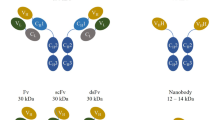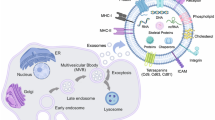Abstract
Exosomes (EXO) are acellular vehicles used for cancer immunotherapy due to their immune inducing properties. To identify whether designed structure based on tumoral EXO have a cytotoxic effect together with a potent immunological property, we synthesized a novel structure based on EXO and staphylococcal entrotoxin B (SEB), two immune inducer substances, and surveyed its cytostatic effect on the breast cancer cell line. EXO were purified from tumor cells and SEB was anchored on it by protein transfer method. To determine the cytotoxic and apoptosis inducing effect of this structure, treated cells with different concentrations of EXO/SEB were examined by MTT assay and Hoechst staining method. In addition, the expression rate of bcl-2, bax, bak, fas, bcl-xl and the activity of caspase-3 and caspase-9 were assessed. We observed that EXO/SEB significantly decreased the cell proliferation and stimulated apoptosis (P < 0.001) at all concentration after 24 h (P < 0.001). Furthermore, EXO/SEB raised the expression rate of bax and bak (P < 0.001) but no impact on fas and bcl-xl after 48 h. We observed reducing effect of EXO/SEB on the mRNA expression of bcl-2. After 24 h of exposing the cell with the EXO/SEB, a significant increase was found in the activity of caspase at the concentration of 2.5, 5 and 10 μg/100 μl for caspase-9 and at all concentrations for caspase-3 (P < 0.001). Our designed structure, the EXO/SEB, is a novel model for apopto-immunotherapy being able to induce apoptosis in ER− breast cancer cells.








Similar content being viewed by others
References
Ferlay J, Shin HR, Bray F, Forman D, Mathers C, Parkin DM. Estimates of worldwide burden of cancer in 2008: GLOBOCAN 2008. Int J Cancer. 2010;127:2893–917.
Lanari C, Wargon V, Rojas P, Molinolo AA. Antiprogestins in breast cancer treatment: are we ready? Endocr Relat Cancer. 2012;19:R35–50.
Soto-Cerrato V, Llagostera E, Montaner B, Scheffer GL, Perez-Tomas R. Mitochondria-mediated apoptosis operating irrespective of multidrug resistance in breast cancer cells by the anticancer agent prodigiosin. Biochem Pharmacol. 2004;68:1345–52.
Koido S, Homma S, Takahara A, Namiki Y, Tsukinaga S, Mitobe J, et al. Current immunotherapeutic approaches in pancreatic cancer. Clin Dev Immunol. 2011;2011:267539.
Rieger J, Freichels H, Imberty A, Putaux JL, Delair T, Jérôme C, et al. Polyester nanoparticles presenting mannose residues: toward the development of new vaccine delivery systems combining biodegradability and targeting properties. Biomacromolecules. 2009;10:651–7.
Hosseini HM, Fooladi AA, Nourani MR, Ghanezadeh F. Role of Exosome in infectious disease. Inflamm Allergy Drug Targets. 2013;12:29–37.
Schorey JS, Bhatnagar S. Exosome function: from tumor immunology to pathogen biology. Traffic. 2008;9:871–81.
Cho JA, Yeo DJ, Son HY, Kim HW, Jung DS, Ko JK, et al. Exosomes: a new delivery system for tumor antigens in cancer immunotherapy. Int J Cancer. 2005;114:613–22.
Tan A, De La Peña H, Seifalian AM. The application of exosomes as a nanoscale cancer vaccine. Int J Nanomedicine. 2010;5:889–900.
Ristorcelli E, Beraud E, Mathieu S, Lombardo D, Verine A. Essential role of Notch signaling in apoptosis of human pancreatic tumoral cells mediated by exosomal nanoparticles. Int J Cancer. 2009;125:1016–26.
Ristorcelli E, Beraud E, Verrando P, Villard C, Lafitte D, Sbarra V, et al. Human tumor nanoparticles induce apoptosis of pancreatic cancer cells. FASEB J. 2008;22:3358–69.
Choi YW, Kotzin B, Herron L, Callahan J, Marrack P, Kappler J. Interaction of Staphylococcus aureus toxin “superantigens” with human T cells. Proc Natl Acad Sci. 1989;86:8941–5.
Kappler J, Kotzin B, Herron L, Gelfand EW, Bigler RD, Boylston A, et al. V beta-specific stimulation of human T cells by staphylococcal toxins. Science. 1989;244:811–3.
Imani Fooladi AA, Sattari M, Hassan ZM, Mahdavi M, Azizi T, Horii A. In vivo induction of necrosis in mice fibrosarcoma via intravenous injection of type B staphylococcal enterotoxin. Biotechnol Lett. 2008;30:2053–9.
Imani Fooladi AA, Sattari M, Nourani MR. Synergistic effects between staphylococcal enterotoxin type B and monophosphoryl lipid A against mouse fibrosarcoma. J BUON. 2010;15:7.
Fooladi AAI, Sattari M, Nourani MR. Study of T-cell stimulation and cytokine release induced by staphylococcal enterotoxin type B and monophosphoryl lipid A. Arch Med Sci. 2009:335–41.
Higgs BW, Dileo J, Chang WE, Smith HB, Peters OJ, Hammamieh R, et al. Modeling the effects of a Staphylococcal Enterotoxin B (SEB) on the apoptosis pathway. BMC Microbiol. 2006;6:48.
Battke C, Ruiss R, Welsch U, Wimberger P, Lang S, Jochum S, et al. Tumour exosomes inhibit binding of tumour-reactive antibodies to tumour cells and reduce ADCC. Cancer Immunol Immunother. 2011;60:639–48.
Exosome protein and RNA database. ExoCarta 2010 [cited 2010]. Available from: http://exocarta.ludwig.edu.au.
McHugh RS, Nagarajan S, Wang YC, Sell KW, Selvaraj P. Protein transfer of glycosyl-phosphatidylinositol-B7-1 into tumor cell membranes: a novel approach to tumor immunotherapy. Cancer Res. 1999;59:2433–7.
Danial NN, Korsmeyer SJ. Cell death: critical control points. Cell. 2004;116:205–19.
Oltvai ZN, Milliman CL, Korsmeyer SJ. Bcl-2 heterodimerizes in vivo with a conserved homolog, Bax, that accelerates programmed cell death. Cell. 1993;74:609–19.
Devarajan E, Sahin AA, Chen JS, Krishnamurthy RR, Aggarwal N, Brun AM, et al. Down-regulation of caspase 3 in breast cancer: a possible mechanism for chemoresistance. Oncogene. 2002;21:8843–51.
Fadeel B, Orrenius S. Apoptosis: a basic biological phenomenon with wide-ranging implications in human disease. J Intern Med. 2005;258:479–517.
Sharief M, Gani ZH. Garden cress Lepidium sativum seeds as oral contraceptive plant in mice. Saudi Med J. 2004;25:965–6.
Ferenbach DA, Haydon GH, Rae F, Malcomson RD, Harrison DJ. Alteration in mRNA levels of Fas splice variants in hepatitis C-infected liver. J Pathol. 1997;183:299–304.
Marone M, Mozzetti S, De Ritis D, Pierelli L, Scambia G. Semiquantitative RT-PCR analysis to assess the expression levels of multiple transcripts from the same sample. Biol Proced Online. 2001;3:19–25.
Chen JH, Cao JL, Chu YL, Wang ZL, Yang ZT, Wang HL. T-2 toxin-induced apoptosis involving Fas, p53, Bcl-xL, Bcl-2, Bax and caspase-3 signaling pathways in human chondrocytes. J Zhejiang Univ Sci B. 2008;9(6):455–63.
Kim H, Chung H, Kim HJ, Lee JY, Oh MY, Kim Y, et al. Id-1 regulates Bcl-2 and Bax expression through p53 and NF-kappaB in MCF-7 breast cancer cells. Breast Cancer Res Treat. 2008;112(2):287–96.
Banisor I, Kalman B. Bcl-2 and its homologues in the brain of patients with multiple sclerosis. Mult Scler. 2004;10(2):176–81.
Khaheshi I, Keshavarz S, Imani Fooladi AA, Ebrahimi M, Yazdani S, Panahi Y, et al. Loss of expression of TGF-βs and their receptors in chronic skin lesions induced by sulfur mustard as compared with chronic contact dermatitis patients. BMC Dermatol. 2011;11:2.
Acknowledgements
This study was a part of the dissertation of Hamideh Mahmoodzadeh Hosseinini, submitted to Tabriz University of Medical Sciences in partial fulfillment of the requirements for PhD in pharmaceutical biotechnology (No.78). This work was supported by the grant from the Iranian National Sciences Foundation (INSF) and Tabriz University of Medical Sciences.
Conflicts of interest
The authors confirm that this article content has no conflict of interest.
Author information
Authors and Affiliations
Corresponding author
Rights and permissions
About this article
Cite this article
Mahmoodzadeh Hosseini, H., Imani Fooladi, A.A., Soleimanirad, J. et al. Staphylococcal entorotoxin B anchored exosome induces apoptosis in negative esterogen receptor breast cancer cells. Tumor Biol. 35, 3699–3707 (2014). https://doi.org/10.1007/s13277-013-1489-1
Received:
Accepted:
Published:
Issue Date:
DOI: https://doi.org/10.1007/s13277-013-1489-1




